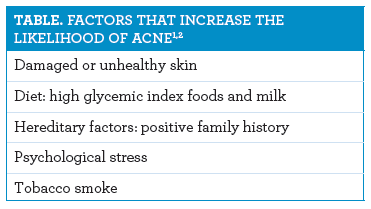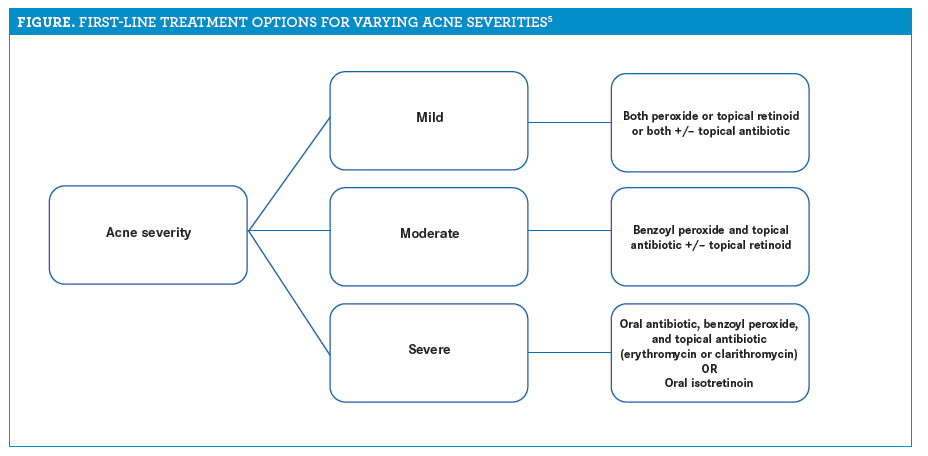Publication
Article
Pharmacy Times
Acne Can Be Troublesome But Responds to Treatment
Author(s):
For best results, address this common, chronic, inflammatory skin condition’s pathogenesis, and consider the possibility of resistance and recurrence.
THE MOST PREVALENT SKIN DISEASE IN THE UNITED STATES, acne vulgaris, affects nearly 50 million people, particularly including many adolescents and young adults.1
This inflammatory skin condition arises from the interplay of 4 processes: androgen-induced increased sebum production, altered keratinization, proliferation and colonization of the pilosebaceous duct by Propionibacterium acnes, and inflammatory mediator release.2 Acne can scar skin and persist for a lifetime, with long-lasting comorbidities and psychosocial effects. The table1,2 identifies potential risk factors.

Research indicates that components of the traditional Western diet are associated with acne development. For example, prospective studies have linked excess sebum production with insulinlike growth factor 1, an androgen mediator, in milk.2 Foods with a high glycemic index, such as highly processed and starchy foods and sugary drinks, have also been linked to increasing acne severity.1,2
Whatever its cause, acne’s impact is multifaceted. Effects range from physical symptoms, such as dyspigmentation, inflammation, and scarring, to long-lasting psychosocial implications, such as anxiety, depression, and low self-esteem.1-3 Health care providers must be aware of this symptom spectrum to guide and provide clinically appropriate care.
A VARIETY OF TREATMENTS
Nonpharmacologic methods for managing acne include proper face hygiene, such as soap-free face wash and oil-free moisturizers, and trigger avoidance of makeup, sunscreen, and medications such as anabolic steroids and corticosteroids.2
The mainstay of managing acne largely falls into pharmacologic management to suppress contributing factors, clear the acne, and reduce scarring. Topical and oral treatment options are available.
The most commonly used topical options are antibiotics, antiseptics, keratolytic agents, and retinoids, which target different processes in acne development.2 Benzoyl peroxide is an effective antimicrobial used topically to kill bacteria and peel the skin, and it is generally used in combination with topical antibiotics or retinoids. Adverse effects (AEs) include bleaching of clothes or linens and skin dryness or irritation, which can be minimized by lowering the strength and applying the product to skin that has been thoroughly dried after cleansing. Unlike other antimicrobial agents, this strong bactericidal medication is not associated with resistance.2
Topical retinoids, such as adapalene, isotretinoin, and tretinoin, are commonly used to treat acne. They normalize the keratinization process to reduce follicular obstruction.2 These agents can cause local irritation and photosensitivity and are teratogenic. This class should be avoided in women who are breastfeeding, pregnant, or planning to become pregnant.2 The oral retinoid isotretinoin has been most effective for severe treatment-resistant acne. It targets all 4 known components of acne development, making it the only treatment that offers remission.2 However, its administration requires frequent monitoring of complete blood cell count, liver function tests, pregnancy testing, serum cholesterol, and triglycerides.3 The most common AEs of isotretinoin used at high doses are rash and anxiety/depressive symptoms that require counseling. Because of possible teratogenicity, the agent’s use in women is tightly regulated.2,4
Both topical and oral antibiotics address increased P acnes. Topical clindamycin and erythromycin have similar efficacies but varying resistance patterns.Resistance is a concern, especially with erythromycin, so current guidelines recommend avoiding topical antibiotic monotherapy.2,3 Instead, a combination with benzoyl peroxide is suggested.2 For oral formulations, a 6-week course of a tetracycline—specifically, doxycycline or minocycline—is commonly used unless contraindicated (ie, for children younger than 8 years old or pregnant patients). In these instances, erythromycin can be an option.2 However, with oral antibiotics, concerns include resistance and posttreatment recurrence. A topical antibiotic regimen for longterm care is essential to prevent recurrence.
Clinicians should select treatment options based on the location and severity of the acne. The figure5 describes suggested first-line therapy options according to American Academy of Dermatology practice guidelines.

Managing acne during pregnancy is an area of interest. Because of the ethical issues associated with conducting studies and trials in pregnant women, human drug safety trials are limited. Benzoyl peroxide, for example, is deemed category C and is safe during pregnancy. It has 5% systemic absorption and is completely metabolized to benzoic acid, creating no systemic toxicity. However, oral isotretinoin is contraindicated in pregnancy and requires strict monitoring throughout treatment because of the risk of fetal malformations.4
Overall, acne is a chronic disease that requires proper management. Understanding the interplay of underlying factors is essential to effective treatment. Combination therapy is warranted, and health care providers need to consider the chance of resistance and recurrence when selecting and monitoring therapy.
Chevannah Hardie is a PharmD candidate at the University of Connecticut School of Pharmacy in Storrs.
REFERENCES
- Oge’ LK, Broussard A, Marshall MD. Acne vulgaris: diagnosis and treatment. Am Fam Physician. 2019;100(8):475-484.
- Cooper AJ, Harris VR. Modern management of acne. Med J Aust. 2017;206(1):41- 45. doi:10.5694/mja16.00516
- Zaenglein AL, Pathy AL, Schlosser BJ, et al. Guidelines of care for the management of acne vulgaris. J Am Acad Dermatol. 2016;74(5):945-73.e33. doi:10.1016/j. jaad.2015.12.037
- Chien AL, Qi J, Rainer B, Sachs DL, Helfrich YR. Treatment of acne in pregnancy. J Am Board Fam Med. 2016;29(2):254-262. doi:10.3122/jabfm.2016.02.150165
- Hauk L. Acne vulgaris: treatment guidelines from the AAD. Am Fam Physician. 2017;95(11):740-741.







